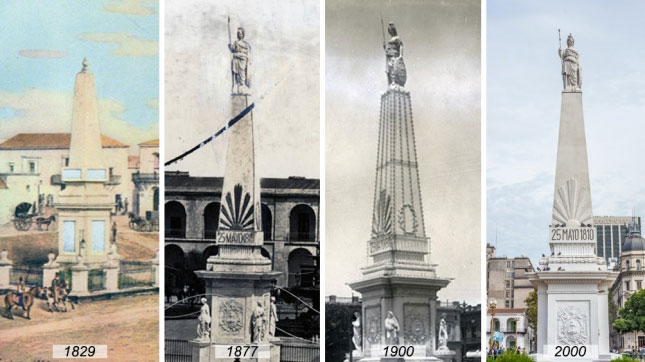Plaza de Mayo, we are going to tell you several curiosities of this famous Plaza in the center of Buenos Aires.
 It is one of the oldest squares in the city. But, it did not always carry this name nor was it as great as we know it today.
It is one of the oldest squares in the city. But, it did not always carry this name nor was it as great as we know it today.
Juan de Garay, founder of the city, in 1580 created the Plaza Mayor. It was a square in what is currently the space of Av. Rivadavia, Defensa, Bolívar and Hipólito Yrigoyen. In the eastern sector, between Yrigoyen, Defensa, Balcarce and Av. Rivadavia, there was an abandoned piece of land that would later become the Plaza de Armas.
These two blocks, in 1884, were merged into a single land with 2 total hectares.
The name it bears is in honor of the Revolution of May 25, 1810.
Here are some other curiosities about this huge Plaza de Mayo:
The Recova
 In the middle of the first two squares that we mentioned before, between 1804 and 1884, was La Recova. A large building, with two bodies with 11 arches in each body, which were joined in the middle by a huge arch and which served as a connection between the squares.
In the middle of the first two squares that we mentioned before, between 1804 and 1884, was La Recova. A large building, with two bodies with 11 arches in each body, which were joined in the middle by a huge arch and which served as a connection between the squares.
It was the first shopping mall in the city of Buenos Aires, where it was possible to buy a variety of products, from clothing and footwear, to vegetables and cuts of meat.
The building was torn down in 1884 for the creation of the current Plaza de Mayo.
Pyramid
 It is the first national monument, which was built in 1811 to honor and remember the first anniversary of the famous May Revolution.
It is the first national monument, which was built in 1811 to honor and remember the first anniversary of the famous May Revolution.
But, here we tell you a secret that few know. The monument that we see is not, in reality, the original, but it is hidden inside the pyramid that we see today. This happens because in 1856 the state of the original pyramid was very neglected, so the artist Prilidiano Pueyrredón built a new pyramid around it. At the top, he added a small statue, representing Liberty with the Phrygian cap, characteristic of the Argentine Republic.
For this reason, what we see today is that coating that was created in 1856 and not its original from 1811.
Hollow of Souls
In ancient times, there was a belief that, on the corner of Av. Rivadavia and Reconquista, the witches, together with the devil, gathered to make covens.
It was an area of unfinished buildings, with small holes where people lay down to sleep. Undoubtedly, an abandoned place is the basis for gloomy stories.
To cover this gap, the First Colón Theater was built.
Executions
This is where we are going to tell you about the least beautiful part of the square.
In the year 1580, and the following years, the western sector of this place was the one chosen for the execution of the prisoners before the eyes of the people. There they were shot or hanged, and their bodies were hung for a couple of hours for all the people to see.
Bulls
Yes, although you may not believe it, it was also a bullfighting area like in Spain.
In 1609, the first bullfight took place in what was still the renowned Plaza Mayor.
Its journey took two centuries until they were abolished. In its heyday, the balconies of the buildings under construction were rented as boxes to better see the horrible spectacle.
The Fort
 In 1595, a fort was built with the idea that it would be a defender of the city against possible pirates of European origin. Its location was where the famous Casa Rosada in Buenos Aires is currently located.
In 1595, a fort was built with the idea that it would be a defender of the city against possible pirates of European origin. Its location was where the famous Casa Rosada in Buenos Aires is currently located.
In 1882 it was demolished, but inside the Casa Rosada Museum you will be able to see some of the remains of this enormous protection.






Leave A Comment